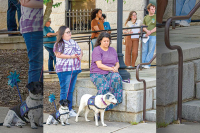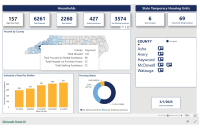In Russ Avenue’s shadow: Neighbors fear commercial creep, struggle with identity crisis
 Waynesville leaders are weighing whether to expand the commercial footprint of Russ Avenue, an issue that has pitted neighbors against each other along the recently widened Howell Mill Road.
Waynesville leaders are weighing whether to expand the commercial footprint of Russ Avenue, an issue that has pitted neighbors against each other along the recently widened Howell Mill Road.
A group of property owners straddling two worlds — the commercial pulse of Russ Avenue on one side and a quiet pocket of homes and rolling hills on the other — have grown weary of being on the front line.
Tom Shook wants to move somewhere quieter, away from the Russ Avenue development flanking him. But his residential zoning is a detriment.
“I have been trying to sell it for several years. A lot of tire kickers, and they always ask ‘Could it be rezoned?’” said Shook. “I am just asking to get best value for my property.”
But the neighbors who live on the other side of Shook fear the commercial creep of Russ Avenue along Howell Mill Road. They worry their own doorsteps could become the new frontline of the commercial.
“We don’t want another Russ Avenue out there,” said Joe Rogers, one of the neighbors.
Related Items
The debate reflects an increasingly common land-use challenge in Waynesville: where to draw the line between the commercial and residential interface?
“It is a larger land-use question of how we handle a transitional area between a growing commercial district and a traditionally residential neighborhood,” Planning Director Elizabeth Teague said. “How do you manage growth in between these two areas? How do you transition between different zoning uses?”
Waynesville’s planning department has gotten half a dozen zoning appeals over the past year from residential property owners on the edge of a commercial district — all of them wanting their property reclassified as commercial.
Town board members haven’t always agreed on what to do. On one hand, they don’t want to stifle commercial growth. But they also don’t want to throw neighbors under the bus by allowing commercial development to inch deeper into a residential district.
The rezoning requests have been handled in piecemeal, case-by-case basis. Twice, they resulted in a rare split decision for the board.
The latest one — the question of whether and how to rezone the Howell Mill corridor — has more at stake than the fate of a single property, Teague said.
The $11.6 million road-widening project along Howell Mill has transformed the two-lane country road to a primary gateway for the commercial hotbed of Russ Avenue.
“The higher visibility and the increased traffic will realize an increased development potential and probably an increased desire to be able to develop by the property owners along that corridor,” Teague said during a preliminary discussion of the issue by the town planning board last week.
Three property owners along Howell Mill with adjoining tracts — totaling seven acres — are seeking commercial zoning designation. They made their case to the town planning board last week, describing their predicament.
Their property abuts the backside of the newly expanded Ingles grocery store and an electrical power substation. It’s fronted by the newly widened Howell Mill Road, and overlooks Sonoco Plastics manufacturing plant to boot.
“There is no way anyone is going to buy three houses that look smack at a packaging facility,” said Karen Hollingsed, the property owners’ real estate agent.
She’s gotten only three calls from potential buyers in five years. They all wanted it for commercial development — not for the three homes that sit on it.
But a quiet residential neighborhood flanks the other side of the property. Tucked behind a knoll, their rural respite is a sharp contrast to the traffic melee on Russ Avenue. Those neighbors fear encroachment of commercial development into their community.
“We are going to be the rear side of whatever goes out there,” said Steve Leonard. “It will be an eyesore for the people directly behind the site. It is very likely our property values will decrease significantly.”
Four of Shook’s neighbors spoke against the rezoning at the planning board meeting last week.
Among them was Ginger Haynes, who harkened back to community land-use discussions in the 1990s, when the zoning designations now on the books were crafted as part of the town’s comprehensive land-use plan.
Haynes said the “meaningful, well-vetted plan” shouldn’t be reversed in piecemeal fashion, but should engage community input and discourse before irreparably altering the vision laid out years ago.
The Waynesville planning board postponed a decision pending a community land-use meeting planned for 5:30 p.m. Monday, April 4, at the Waynesville Recreation Center.
The meeting is aimed at collecting input from residents on how they envision the future of the Howell Mill corridor.
“We wanted to find a way to engage the people along that corridor in what they want to see happen,” Teague said. “The community-wide meeting will give people the opportunity to share what they want to see happen, knowing the road will bring more traffic and there will likely be more pressure for development.”
Teague hopes to learn whether there is middle ground between those seeking broader commercial designation and those hoping to preserve the residential character.
Shook and the other two property owners want to be reclassified as part of Russ Avenue’s high-intensity commercial district, which allows everything from drive-thrus to digital signage to retail stores with a footprint of up to 100,000 square feet.
“Part of the discussion is what is the middle ground. Maybe it is not Russ Avenue zoning, but maybe it is something else,” Teague said.
Options could include higher density residential development, allowing for condos and apartment complexes, cluster development, or mixed-use that allows a blend of lower-impact commercial development coupled with more intensive residential development.









